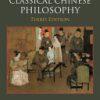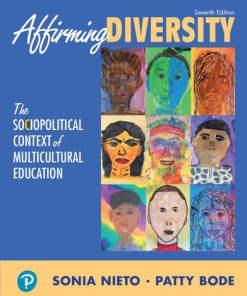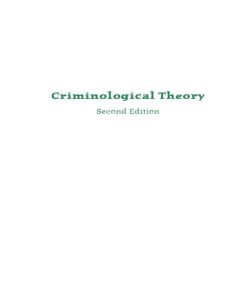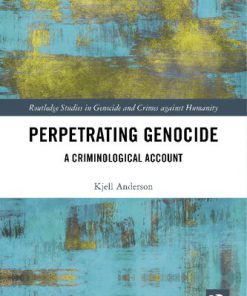Criminological Theory Context and Consequences 7th Edition by Robert Lilly, Francis Cullen, Richard Ball ISBN 9781506387307 1506387306
$50.00 Original price was: $50.00.$25.00Current price is: $25.00.
Criminological Theory Context and Consequences 7th Edition by Robert Lilly, Francis Cullen, Richard Ball – Ebook PDF Instant Download/Delivery: 9781506387307 ,1506387306
Full download Criminological Theory Context and Consequences 7th Edition after payment
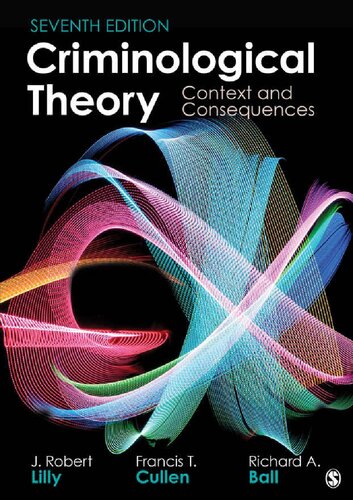
Product details:
ISBN 10: 1506387306
ISBN 13: 9781506387307
Author: Robert Lilly, Francis Cullen, Richard Ball
Criminological Theory Context and Consequences 7th Edition Table of contents:
Chapter 1 • The Context and Consequences of Theory
Theory in Social Context
Theory and Policy: Ideas Have Consequences
Context, Theory, and Policy: Plan of the Book
Inventing Criminology: Mainstream Theories
Social Turmoil and the Rise of Critical Theories
Criminological Theory in the Conservative Era
Criminological Theory in the 21st Century
Conclusion
Further Readings
Chapter 2 • The Search for the “Criminal Man”
Spiritualism
The Classical School: Criminal as Calculator
The Positivist School: Criminal as Determined
The Birth of the Positivist School: Lombroso’s Theory of the Criminal Man
Lombroso’s Legacy: The Italian Criminological Tradition
The Continuing Search for the Individual Roots of Crime
The Consequence of Theory: Policy Implications
The Positivist School and the Control of the Biological Criminal
The Positivist School and Criminal Justice Reform
Conclusion
Further Readings
Chapter 3 • Rejecting Individualism: The Chicago School
The Chicago School of Criminology: Theory in Context
Shaw and McKay’s Theory of Juvenile Delinquency
Burgess’s Concentric Zone Theory
Disorganization and Delinquency
Transmission of Criminal Values
The Empirical Status of Social Disorganization Theory
Summary
Sutherland’s Theory of Differential Association
Differential Social Organization
Differential Association
Theoretical Applications
The Chicago School’s Criminological Legacy
Control and Culture in the Community
Collective Efficacy Theory
Cultural Attenuation Theory
Cultural Deviance Theory
Anderson’s Code of the Street
Akers’s Social Learning Theory
Becoming a Learning Theorist
Extending Sutherland: Akers’s Theory
Assessing Social Learning Theory
The Consequences of Theory: Policy Implications
Change the Individual
Change the Community
Conclusion
Further Readings
Chapter 4 • Crime in American Society: Anomie and Strain Theories
Merton’s Strain Theory
America as a Criminogenic Society
Strain Theory in Context
Status Discontent and Delinquency
Delinquent Boys
Delinquency and Opportunity
The Criminological Legacy of “Classic” Strain Theory
Agnew’s General Strain Theory
Becoming a Strain Theorist
Three Types of Strain
Coping With Strain
Assessing General Strain Theory
Two Theoretical Extensions
Crime and the American Dream: Institutional-Anomie Theory
Inventing Institutional-Anomie Theory
The American Dream and Anomie
Institutional Balance of Power
Assessing Institutional-Anomie Theory
The Market Economy and Crime
The Future of Strain Theory
The Consequences of Theory: Policy Implications
Expand Opportunities
Taming the American Dream
Conclusion
Further Readings
Chapter 5 • Society as Insulation: The Origins of Control Theory
Forerunners of Control Theory
Durkheim’s Anomie Theory
The Influence of the Chicago School
Early Control Theories
Reiss’s Theory of Personal and Social Controls
Nye’s Family-Focused Theory of Social Controls
Reckless’s Containment Theory
The Social Psychology of the Self
Pushes and Pulls
Factors in Outer Containment
Factors in Inner Containment
Summary
Sykes and Matza: Neutralization and Drift Theory
Techniques of Neutralization
Subterranean Values
Drift Theory
Control Theory in Context
The Context of the 1950s
The Context of the 1960s
Further Readings
Chapter 6 • The Complexity of Control: Hirschi’s Two Theories and Beyond
Hirschi’s First Theory: Social Bonds and Delinquency
Hirschi’s Forerunners
Hirschi’s Sociological Perspective
Why Social Control Matters
The Four Social Bonds
Assessing Social Bond Theory
Hirschi’s Second Theory: Self-Control and Crime
Self-Control and Crime
Assessing Self-Control Theory
Self-Control and Social Bonds
Hirschi’s Revised Self-Control Theory
A Final Statement of Self-Control Theory: Four Points
Self-Control and Vulnerability to Victimization
The Complexity of Control
Hagan’s Power-Control Theory
Tittle’s Control Balance Theory
Colvin’s Differential Coercion Theory
Beyond Control: Cullen’s Social Support Theory
The Consequences of Theory: Policy Implications
Conclusion
Further Readings
Chapter 7 • The Irony of State Intervention: Labeling Theory
Labeling Theory in Context
The Social Construction of Crime
Labeling as Criminogenic: Creating Career Criminals
Early Statements of Labeling Theory
Labeling as a Self-Fulfilling Prophecy
Assessing Labeling Theory: Explaining Societal Reaction
Assessing Labeling Theory: The Criminogenic Proposition
The Consequences of Theory: Policy Implications
Decriminalization
Diversion
Due Process
Deinstitutionalization
Extending Labeling Theory
Braithwaite’s Theory of Shaming and Crime
Sherman’s Defiance Theory
Tyler’s Procedural Justice Theory
Rose and Clear’s Coerced Mobility Theory
Policy Implications: Restorative Justice and Prisoner Reentry
Conclusion
Further Readings
Chapter 8 • Social Power and the Construction of Crime: Conflict Theory
Forerunners of Conflict Theory
Marx and Engels: Capitalism and Crime
Simmel: Forms of Conflict
Bonger: Capitalism and Crime
Sutherland and Sellin: Culture Conflict and Crime
Vold: Conflict and Crime
Theory in Context: The Turmoil of the 1960s
Advancing Conflict Theory: Turk, Chambliss, and Quinney
Turk: The Criminalization Process
Chambliss: Crime, Power, and Legal Process
Quinney: Social Reality, Capitalism, and Crime
Conflict Theory and the Causes of Crime
Consequences of Conflict Theory
Marxist Approach
Peacemaking Criminology
Braithwaite’s Theory of Macrocriminology and Freedom
Domination and Crime
Crime and Cascades
Consequences: Strengthen Freedom to Prevent Crime
Conclusion
Further Readings
Chapter 9 • The Variety of Critical Theory
The New Criminology: Early Influences
Background
Theoretical Arguments
Critique of the New Criminology
Early Left Realism
The Theory
Consequences of New Criminology/Left Realism
The New Criminology Revisited: A Shift in Context
Left Realism Today
Taking Stock
Late Modernity and Globalization: Major Historical Changes
Early Cultural Criminology
The Beginning
Consequences of Early Cultural Criminology
Cultural Criminology Today
Green/Cultural Criminology
Background and Emergence
Environmental Justice
Ecological Justice
Animal Rights
Rural Critical Criminology
Background
Key Theoretical Elements and Research
Convict Criminology
Primarily an American Contribution
Consequences of the “New School of Convict Criminology”
Abolitionism
The Theory
Context
Consequences
New Directions in Criminological Theory: Death and Birth of New Ideas
Background and Transition
Hall’s New Perspective: 2012–2018
Ultra-Realism
The Importance of Other Voices: Jock Young
Contemporary British Context: Consequences
Conservative Era Continues
Immigration, Race, and the Police
Post-Brexit: Policies and Crime
Conclusion
Further Readings
Chapter 10 • The Gendering of Criminology: Feminist Theory
Background
Prefeminist Pioneers and Themes
Cesare Lombroso
W. I. Thomas
Sigmund Freud
Otto Pollak
The Emergence of New Questions: Bringing Women In
The Second Wave: From Women’s Emancipation to Patriarchy
Women’s Emancipation and Crime
Patriarchy and Crime
Varieties of Feminist Thought
Early Feminist Perspectives
Contemporary Feminist Perspectives
The Intersection of Race, Class, and Gender
Masculinities and Crime
Doing Gender
Male Peer Support Theory
Gendering Criminology
Gendered Pathways to Lawbreaking
Gendered Crime
Gendered Lives
A Gendered Theory of Offending
The Gender Gap: Further Comments
Queer Criminology
Postmodernist Feminism and the Third Wave Revisited
Consequences of Feminist Theory: Policy Implications
Consequences of the Diversity of Feminist Perspectives
Consequences of Feminist Criminology for Corrections
Consequences of Feminist Criminology: Background and New Directions
Conclusion
Further Readings
Chapter 11 • Crimes of the Powerful: Theories of White-Collar Crime
The Discovery of White-Collar Crime: Edwin H. Sutherland
The Philadelphia Address
Becoming the Father of White-Collar Crime
Defining White-Collar Crime
Explaining White-Collar Crime
Organizational Culture
Unethical Cultures
Oppositional Cultures
The Normalization of Deviance
Organizational Strain and Opportunity
Strain and Anomie
Criminogenic Opportunities
Deciding to Offend
Denying the Guilty Mind
White-Collar Crime as a Rational Choice
White-Collar Offenders as Bad Apples
White Racial Privilege
State-Corporate Crime
Consequences of White-Collar Crime Theory: Policy Implications
Conclusion
Further Readings
Chapter 12 • Bringing Punishment Back In: Conservative Criminology
Context: The United States of the 1980s and early 1990s
The Economic Decline of the United States
The Persistence of Inequality in the United States
The Rhetoric of Stability
The Legacy of the Conservative Political Agenda
Varieties of Conservative Theory
Crime and Human Nature: Wilson and Herrnstein
The Theory
Assessing Crime and Human Nature
Crime and The Bell Curve: Herrnstein and Murray
The Criminal Mind
Choosing to Be Criminal: Crime Pays
Crime and Moral Poverty
Broken Windows: The Tolerance of Public Disorganization
Consequences of Conservative Theory: Policy Implications
The Embrace of Mass Imprisonment
Incapacitating the Wicked
“Get Tough” Alternatives
Conclusion
Further Readings
Chapter 13 • Conservatism in Context: Contemporary Developments
The New Conservativism, Shock Doctrine, and Dark Money
The Shock Doctrine
Dark Money
The War on Terror and the Rise of Hate Crimes
The Precariousness of the Rule of Law
Politicization of the U.S. Supreme Court
Concentration of Power
The Big Lie
Big Data, Surveillance, and the Epistemic Coup
Big Data and Surveillance
Social Construction of Reality
The Epistemic Coup
Economic Instability and Inequality
The Great Recession
Beyond the Great Recession
COVID-19 Pandemic Crisis
Postpandemic Developments
Conclusion: The New Normal
Further Readings
Chapter 14 • Choosing Crime in Everyday Life: Routine Activity and Rational Choice Theories
Routine Activity Theory: Opportunities and Crime
The Chemistry for Crime: Offenders, Targets, and Guardians
View of Offenders
Policy Implications: Reducing Opportunities for Crime
Rational Choice Theory
Rational Choice and Crime
Policy Implications
Are Offenders’ Choices Rational?
Perceptual Deterrence Theory
The Theory
Assessing Perceptual Deterrence Theory
Policy Implications: Certainty, Not Severity
Situational Action Theory
Conclusion
Further Readings
Chapter 15 • The Search for the “Criminal Man” Revisited: Biosocial Theories
Evolutionary Psychology: Darwin Revisited
Theoretical Diversity
Assessment
Social Concern Theory: Evolutionary Psychology Revisited
Neuroscience: Neurological and Biochemical Theories
Neurological Theories
Biochemical Theories
Assessment
Genetics
Behavior Genetics
Gene-Environment Correlations (rGEs)
Epigenetics
Assessment
Conclusion
Further Readings
Chapter 16 • New Directions in Biosocial Theory: Perspectives and Policies
Biosocial Risk and Protective Factors
Risk Factors
Protective Factors
Environmental Toxins
The Consequences of Theory: Policy Implications
An Agenda for Research and Policy
Implications for Prevention and Treatment
Problems of Definition and the Social Construction of Crime
Challenges Ahead
Conclusion
Further Readings
Chapter 17 • The Development of Criminals: Life-Course Theories
Integrated Theories of Crime
Integrated Theorizing
Elliott and Colleagues’ Integrated Strain-Control Paradigm
Thornberry’s Interactional Theory
Hawkins and Catalano’s Social Development Model
Farrington’s ICAP Theory
Policy Implications
Life-Course Criminology: Continuity and Change
Criminology in Crisis: Gottfredson and Hirschi Revisited
Patterson’s Social-Interactional Developmental Model
Early-Onset Delinquency
Late-Onset Delinquency
Intervening With Families
Moffitt’s Life-Course-Persistent/Adolescence-Limited Theory
Life-Course-Persistent Antisocial Behavior
Adolescence-Limited Antisocial Behavior
Assessing Moffitt’s Theory
Sampson and Laub: Social Bond Theory Revisited
An Age-Graded Theory of Informal Social Control
Assessing Sampson and Laub’s Life-Course Theory
Revising the Age-Graded Theory of Crime
Rethinking Crime: Cognitive Theories of Desistance
Maruna’s Theory of Redemption Scripts
Giordano et al.’s Theory of Cognitive Transformation
Paternoster and Bushway’s Theory of the Feared Self
The Consequences of Theory: Policy Implications
Conclusion
Further Readings
Chapter 18 • Black Criminology: Theories of Race and Crime
Black Criminology in Context
Two Attacks: Beyond Black Inferiority
The Blank Slate
Racial Invariance Thesis
W. E. Burghardt Du Bois: The Philadelphia Negro
Ignoring Du Bois
Becoming a Scholar
Studying Philadelphia’s “Negro Problem”
Du Bois’s Theory of Crime
Consequences
Conclusion
Contemporary Black Criminology: Three Theories
Unnever and Gabbidon’s Theory of African American Offending
Burt and Simons’s Racialized Social Schematic Theory
Eck and Linning’s Racial Place Management Theory
Conclusion
Looking to the Future
Further Readings
References
People also search for Criminological Theory Context and Consequences 7th Edition:
criminological theory context and consequences 7th edition pdf free
criminological theory context and consequences pdf
criminological theory context and consequences 7th edition pdf
criminological theory context and consequences 8th edition pdf
criminological theory context and consequences 7th edition ebook
Tags:
Robert Lilly,Francis Cullen,Richard Ball,Criminological Theory,Context,Consequences
You may also like…
Education Studies & Teaching
Affirming Diversity: The Sociopolitical Context of Multicultural Education 7th Edition Sonia Nieto
Uncategorized
Criminological Theory The Essentials 2nd Edition by Stephen G Tibbetts ISBN 9781483359526 1483359522
Jurisprudence & Law - Criminal Law & Procedure
Languages - English as a Foreign Language & Reference
Society Politics Philosophy Government Politics
Leadership Theory and Practice 7th Edition by Peter Northouse
Medicine - Cardiology
Education Studies & Teaching - Education - General & Miscellaneous
Chemistry in Context for Cambridge International AS & A Level 7th Edition Graham Hill
Politics & Philosophy - International Relations
International Relations Theory 7th Edition by Kauppi 9781538171509 1538171503


